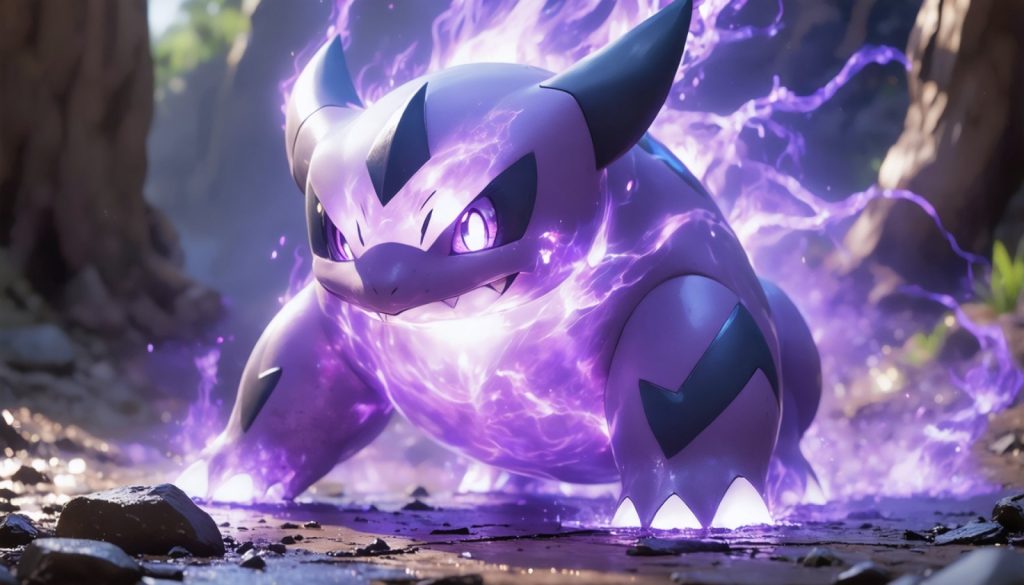
Vibrava: The Sonic Marvel of the Pokémon World. Discover How This Dragonfly Pokémon’s Unique Abilities and Evolutionary Path Make It a Fan Favorite and a Competitive Asset. (2025)
- Introduction to Vibrava: Origins and Lore
- Biological Design: Anatomy and Inspirations
- Type Analysis: Ground and Dragon Synergy
- Signature Moves and Battle Strategies
- Evolutionary Line: From Trapinch to Flygon
- Appearances in Games, Anime, and Merchandise
- Competitive Viability and Meta Trends
- Fan Community and Cultural Impact
- Market and Public Interest: Trends and Forecasts
- Future Outlook: Upcoming Features and Potential Developments
- Sources & References
Introduction to Vibrava: Origins and Lore
Vibrava is a Ground- and Dragon-type Pokémon introduced in the third generation of the Pokémon franchise, first appearing in the “Pokémon Ruby” and “Pokémon Sapphire” video games released in 2002. As the evolved form of Trapinch, Vibrava occupies a unique place in the Pokémon world, bridging the gap between its antlion-inspired larval stage and its final evolution, Flygon. The design and lore of Vibrava draw inspiration from real-world insects, particularly the adult stage of antlions, which are known for their delicate, lattice-like wings and their transformation from predatory larvae. This evolutionary theme is reflected in Vibrava’s in-game characteristics and its role within the broader Pokémon ecosystem.
According to the official Pokédex entries, Vibrava is known as the “Vibration Pokémon.” Its wings are not fully developed for flight, but they are capable of producing ultrasonic waves by rapidly vibrating. These vibrations are said to cause headaches in humans and other Pokémon, a trait that highlights Vibrava’s unique adaptation and its connection to sound-based abilities. The lore suggests that Vibrava uses these vibrations both for communication and to subdue prey, echoing the behaviors of certain real-world insects that use sound as a means of interaction or defense.
Vibrava’s origins are deeply rooted in the creative process of The Pokémon Company and Nintendo, the primary organizations responsible for the development and global distribution of the Pokémon franchise. The Pokémon’s design was crafted by Game Freak, the main development studio behind the core series games, which is known for drawing inspiration from natural history and folklore to create imaginative creatures. The evolutionary line of Trapinch, Vibrava, and Flygon is often cited as an example of the franchise’s ability to blend scientific concepts with fantasy, introducing players to the wonders of metamorphosis and adaptation through engaging gameplay and storytelling.
In the broader context of Pokémon lore, Vibrava is often depicted inhabiting arid environments such as deserts, where it continues the life cycle begun by Trapinch. Its presence in various media—including video games, the animated series, and official trading cards—underscores its popularity and enduring appeal among fans. As the Pokémon franchise continues to expand into 2025 and beyond, Vibrava remains a testament to the enduring creativity and scientific curiosity that define the world of Pokémon.
Biological Design: Anatomy and Inspirations
Vibrava, a Pokémon species introduced in the third generation of the franchise, exemplifies the creative fusion of real-world biological concepts and imaginative design that characterizes many Pokémon. Classified as the “Vibration Pokémon,” Vibrava is the evolved form of Trapinch and serves as the intermediary stage before Flygon. Its design draws heavily from the natural world, particularly from insects in the order Odonata, which includes dragonflies and damselflies. The Pokémon’s slender, segmented body, large rhomboid wings, and prominent eyes are reminiscent of these agile aerial predators, reflecting a careful study of entomological anatomy.
Vibrava’s most distinctive anatomical feature is its pair of large, green, diamond-shaped wings. Unlike the rounded or elongated wings of many real insects, these geometric wings suggest a stylized interpretation, but their function aligns with biological principles. In the Pokémon universe, Vibrava generates ultrasonic waves by rapidly vibrating its wings, a trait inspired by the real-world phenomenon of stridulation—where insects such as crickets and some dragonflies produce sound by rubbing body parts together. This adaptation is not only a nod to insect communication and defense mechanisms but also serves as a narrative device, as Vibrava’s sound waves are said to cause headaches in humans and Pokémon alike.
The Pokémon’s body structure further emphasizes its insectoid inspiration. Vibrava’s segmented abdomen, thin legs, and relatively small head mirror the morphology of nymphal and adult dragonflies. Its large, compound-like eyes suggest acute vision, a trait essential for predatory insects that rely on sight to hunt. The muted tan and green coloration of Vibrava’s body also echoes the camouflage strategies employed by many real insects to evade predators and ambush prey.
From a design perspective, Vibrava’s evolutionary line reflects metamorphosis, a fundamental biological process in insects. Trapinch, its pre-evolution, resembles a larval or nymph stage, while Vibrava’s more developed wings and agile form represent the transition toward adulthood, culminating in the fully mature Flygon. This progression mirrors the transformation from larva to adult seen in holometabolous insects, reinforcing the educational and biological underpinnings of the species’ design.
The creative team at The Pokémon Company and Nintendo have consistently drawn from zoological sources to craft Pokémon like Vibrava, blending scientific accuracy with fantasy to engage players and foster curiosity about the natural world.
Type Analysis: Ground and Dragon Synergy
Vibrava, introduced in Generation III of the Pokémon franchise, is notable for its unique dual typing: Ground and Dragon. This combination is relatively rare within the Pokémon universe and provides Vibrava with a distinctive set of strengths and weaknesses that influence its role in battles and its evolutionary trajectory. The Ground/Dragon synergy is a defining characteristic that shapes Vibrava’s competitive viability and ecological niche.
The Ground type grants Vibrava immunity to Electric-type moves, a significant advantage in battles where Electric attacks are prevalent. Additionally, Ground-type moves are super effective against Fire, Electric, Poison, Rock, and Steel types, giving Vibrava offensive versatility. The Dragon typing, meanwhile, offers resistance to Fire, Water, Grass, and Electric moves, further enhancing Vibrava’s defensive profile. However, this synergy also introduces notable vulnerabilities: Vibrava is doubly weak to Ice-type moves due to both Ground and Dragon types being susceptible to Ice, making it particularly vulnerable to opponents wielding Ice-type attacks. It is also weak to Dragon and Fairy moves, the latter of which was introduced in Generation VI to balance the dominance of Dragon types.
From a gameplay perspective, the Ground/Dragon combination allows Vibrava to access a diverse movepool. It can learn powerful Ground-type moves such as Earthquake and Dragon-type moves like Dragon Breath, enabling it to target a wide array of opponents. This versatility is further enhanced by its ability to learn moves from other types, such as Rock Slide and Steel Wing, broadening its tactical options in both player-versus-player and player-versus-environment scenarios.
The synergy between Ground and Dragon types is also reflected in Vibrava’s evolutionary line. As the evolved form of Trapinch and the precursor to Flygon, Vibrava serves as a transitional stage, inheriting the pure Ground typing of Trapinch and preparing for the more balanced stat distribution and movepool of Flygon. This progression highlights the design philosophy of the Pokémon franchise, which often uses dual typing to create dynamic and strategically interesting species that encourage players to consider type matchups and team composition.
The official Pokémon franchise, managed by The Pokémon Company—a joint venture between Nintendo, Game Freak, and Creatures Inc.—continues to emphasize the importance of type synergy in both the mainline games and competitive formats. Vibrava’s Ground/Dragon typing exemplifies how thoughtful type combinations can create unique gameplay experiences and strategic depth within the Pokémon ecosystem.
Signature Moves and Battle Strategies
Vibrava, the Vibration Pokémon, is a Ground/Dragon-type species introduced in Generation III of the Pokémon franchise. While it does not possess a “signature move” in the strictest sense—meaning a move exclusive to Vibrava and its evolutionary line—it is closely associated with certain moves and battle strategies that leverage its unique typing and abilities. Vibrava’s access to a diverse movepool, combined with its Levitate ability, shapes its role in competitive and casual battles.
One of Vibrava’s most notable moves is Earthquake, a powerful Ground-type attack that benefits from same-type attack bonus (STAB) and is further enhanced by Vibrava’s immunity to Ground-type moves due to Levitate. This allows Vibrava to switch into predicted Ground-type attacks and retaliate effectively. Additionally, Vibrava can learn Dragon Breath and Dragon Tail, both of which take advantage of its Dragon typing and can be used to inflict status conditions or force switches in battle.
Vibrava’s movepool also includes U-turn, a Bug-type move that allows it to pivot out of unfavorable matchups while dealing chip damage. This move is particularly useful in team strategies that rely on maintaining momentum and scouting the opponent’s actions. Furthermore, Vibrava can utilize Roost to recover HP, increasing its longevity in battle, and Defog to remove entry hazards, supporting its team in a utility role.
In terms of battle strategies, Vibrava is often used as a utility Pokémon in lower-tier competitive formats. Its combination of Ground and Dragon typing, along with Levitate, grants it several useful resistances and immunities. Trainers may employ Vibrava as a hazard remover, a pivot, or a revenge killer, depending on the team’s needs. Its speed and access to priority moves like Quick Attack (via breeding) can also be leveraged to finish off weakened opponents.
While Vibrava’s base stats are modest compared to fully evolved Pokémon, its versatility and unique typing make it a valuable asset in specific battle scenarios. Its evolution, Flygon, inherits and expands upon these strategies, but Vibrava’s niche as a mid-stage Pokémon remains relevant in certain competitive environments, especially where Flygon is not permitted or when a team requires a lighter, more flexible option.
For official details on Vibrava’s moves, abilities, and competitive usage, refer to the The Pokémon Company, which manages the official Pokémon database and competitive resources.
Evolutionary Line: From Trapinch to Flygon
Vibrava is a Ground- and Dragon-type Pokémon that occupies the middle stage in a distinctive evolutionary line, bridging the gap between Trapinch and Flygon. This evolutionary sequence is notable for its dramatic transformation in both form and abilities, reflecting the broader themes of metamorphosis and adaptation found throughout the Pokémon franchise. Vibrava first appeared in the third generation of Pokémon games, debuting in Pokémon Ruby and Sapphire in 2002, and has since remained a staple in the series’ regional Pokédexes.
The evolutionary journey begins with Trapinch, a small, antlion-inspired Pokémon known for its powerful jaws and ground-dwelling habits. Trapinch evolves into Vibrava starting at level 35. This evolution marks a significant shift: Vibrava gains wings and a more dragon-like appearance, symbolizing its transition from a terrestrial to an aerial lifestyle. The change is not merely cosmetic; Vibrava’s new form grants it the ability to learn a wider array of moves, including Dragon- and Flying-type attacks, and it acquires the Levitate ability, which provides immunity to Ground-type moves. This adaptation is a key strategic advantage in battles, as it allows Vibrava to avoid many common threats faced by its pre-evolution.
Vibrava’s evolutionary line culminates with its transformation into Flygon at level 45. Flygon, often referred to as the “Desert Spirit,” is renowned for its speed, versatility, and unique typing. The evolutionary progression from Trapinch to Flygon via Vibrava is one of the more dramatic in the Pokémon world, with each stage representing a distinct ecological niche and battle role. This line exemplifies the franchise’s creative approach to evolution, drawing inspiration from real-world insect metamorphosis and dragon mythology.
The evolutionary mechanics and lore surrounding Vibrava and its relatives are detailed in official resources provided by The Pokémon Company, the organization responsible for managing the Pokémon brand worldwide. The Pokémon Company, a joint venture between Nintendo, Game Freak, and Creatures Inc., oversees the development, marketing, and licensing of all Pokémon-related content, ensuring consistency and depth in the portrayal of species like Vibrava across games, trading cards, and animated media.
In summary, Vibrava serves as a pivotal stage in one of the Pokémon series’ most iconic evolutionary lines, embodying the themes of growth, adaptation, and transformation that are central to the franchise’s enduring appeal.
Appearances in Games, Anime, and Merchandise
Vibrava, the Vibration Pokémon, has maintained a consistent presence across the Pokémon franchise since its introduction in Generation III. As the evolved form of Trapinch and the precursor to Flygon, Vibrava is recognized for its unique Ground/Dragon typing and its dragonfly-inspired design. Its appearances span mainline video games, the anime series, and a variety of official merchandise, reflecting its enduring popularity among fans.
In the core video game series, Vibrava first appeared in Pokémon Ruby and Pokémon Sapphire (2002), where players could evolve Trapinch into Vibrava at level 35. Since then, Vibrava has been included in numerous mainline titles, including remakes and spin-offs. In Pokémon Sword and Pokémon Shield, Vibrava is available through transfer and special events, while in Pokémon Scarlet and Pokémon Violet, it can be obtained via in-game trades or through the Pokémon HOME service, which allows players to transfer Pokémon between compatible games. Vibrava is also featured in side games such as Pokémon GO, where it can be encountered in the wild and evolved from Trapinch using in-game resources. Its moveset typically emphasizes its Ground and Dragon attributes, with access to attacks like Dragon Breath, Earth Power, and Bug Buzz, making it a versatile choice in battles and competitions. The official game developer, The Pokémon Company, regularly updates its availability and movesets to maintain balance and player engagement.
In the Pokémon anime, Vibrava made its debut during the Hoenn region arc, specifically in the episode “Beg, Burrow and Steal!” where a group of wild Vibrava is featured. The anime highlights Vibrava’s ability to generate ultrasonic waves with its wings, a trait that is also referenced in its Pokédex entries. While not a primary companion to any main character, Vibrava has appeared in various episodes, often depicted in its natural habitat or as part of a Trainer’s team during tournaments and battles. These appearances help to showcase its evolutionary line and unique abilities to a broad audience.
Vibrava’s presence extends to official merchandise, including trading cards in the Pokémon Trading Card Game, plush toys, figures, and apparel. The Pokémon Center, the official retail arm of The Pokémon Company, periodically releases Vibrava-themed products, especially during events or anniversaries celebrating the Hoenn region. Its distinctive design and role in the evolutionary line make it a popular choice for collectors and fans of Dragon-type Pokémon.
Competitive Viability and Meta Trends
Vibrava, the Vibration Pokémon, occupies a unique niche in competitive Pokémon battling, particularly in formats that allow lower-tier or unevolved Pokémon. As a Ground/Dragon-type, Vibrava possesses a rare typing combination that grants it immunities to Electric-type moves and resistances to Poison and Rock, while being weak to Ice, Dragon, and Fairy attacks. Its stat distribution, with a base Speed of 70 and access to utility moves, shapes its role in the competitive meta.
In 2025, Vibrava’s competitive viability remains limited in standard formats such as those governed by The Pokémon Company International and the official rulesets of the Pokémon Video Game Championships (VGC). Its fully evolved form, Flygon, is generally preferred due to superior stats and movepool. However, Vibrava finds a place in specialized formats like Little Cup (LC) and NFE (Not Fully Evolved) tiers, where only unevolved or partially evolved Pokémon are permitted. In these environments, Vibrava’s access to Defog, U-turn, and Roost makes it a valuable support Pokémon, capable of removing entry hazards and pivoting to teammates.
Vibrava’s ability, Levitate, is a significant asset, granting it immunity to all Ground-type moves, which is especially useful in metagames where Earthquake and other Ground-type attacks are prevalent. This allows Vibrava to switch into predicted Ground-type moves and provide team support. Its movepool includes Earthquake, Dragon Claw, and utility options like Toxic and Tailwind, enabling it to function as a versatile utility or support Pokémon. However, its low base stats, particularly in HP and defenses, limit its ability to withstand repeated attacks from stronger opponents.
Meta trends in 2025 continue to favor Pokémon with higher base stats and offensive pressure, which restricts Vibrava’s usage in upper tiers. Nonetheless, in restricted formats, Vibrava’s unique combination of typing, ability, and support moves allows it to carve out a niche. It is often used as a hazard remover or a pivot, especially on teams that require Ground immunity and hazard control. The continued popularity of hazard-setting Pokémon in lower tiers ensures that Vibrava’s Defog remains a valuable asset.
Overall, while Vibrava is not a staple in high-level competitive play, its specialized utility in certain formats and its unique attributes ensure it remains a relevant choice for trainers seeking creative team compositions in 2025. For official format details and tiering, players can refer to resources provided by The Pokémon Company International.
Fan Community and Cultural Impact
Vibrava, the Vibration Pokémon introduced in Generation III, has maintained a modest yet enduring presence within the global Pokémon fan community. As the middle evolution between Trapinch and Flygon, Vibrava is often discussed in online forums, fan art, and competitive battling circles, reflecting its unique design and role in the Pokémon ecosystem. The Pokémon’s dragonfly-inspired appearance and its transition from a ground-based to a dragon-type Pokémon have inspired creative interpretations and discussions among fans, particularly regarding its evolutionary symbolism and battle strategies.
On platforms such as the official The Pokémon Company International website, Vibrava is featured in Pokédex entries, trading card game expansions, and animated series episodes, ensuring its continued visibility. The Pokémon’s distinctive traits—such as its ability to generate ultrasonic waves with its wings—have been highlighted in various media, contributing to its recognition among both casual and dedicated fans. Community-driven sites and social media groups frequently showcase Vibrava in fan art competitions, cosplay, and themed events, underscoring its appeal as a transitional and dynamic species.
Vibrava’s cultural impact is also evident in its presence at official events and tournaments. While not as prominent as its evolved form, Flygon, Vibrava occasionally appears in competitive play, especially in formats that emphasize creative team-building or lower-tier Pokémon. This has led to discussions about its strategic value and niche roles, fostering a sense of appreciation for underrepresented species within the community. The Pokémon’s inclusion in merchandise, such as plush toys and trading cards, further cements its place in the broader Pokémon culture curated by The Pokémon Company International.
In 2025, the ongoing popularity of the Pokémon franchise ensures that Vibrava remains a subject of interest. New game releases, updates to the animated series, and expansions in the trading card game continue to introduce Vibrava to new generations of fans. The Pokémon’s adaptability and unique characteristics make it a frequent topic in fan theories, evolutionary discussions, and creative projects. As the franchise evolves, Vibrava’s role as a bridge between its pre-evolved and final forms symbolizes growth and transformation, resonating with fans who appreciate the deeper narratives within the Pokémon world.
Market and Public Interest: Trends and Forecasts
Vibrava, the Vibration Pokémon introduced in Generation III of the Pokémon franchise, continues to maintain a notable presence in the global Pokémon market and fan community as of 2025. As an evolved form of Trapinch and a precursor to Flygon, Vibrava occupies a unique niche in both the Pokémon video games and the broader merchandise ecosystem. The Pokémon franchise, managed by The Pokémon Company—a joint venture between Nintendo, Game Freak, and Creatures Inc.—has consistently leveraged its diverse roster of species, including Vibrava, to sustain engagement and drive commercial success.
Market trends indicate that interest in mid-evolution Pokémon like Vibrava is closely tied to game releases, trading card expansions, and animated series appearances. In 2025, the continued rollout of mainline titles and spin-off games for the Nintendo Switch and anticipated next-generation hardware has ensured that Vibrava remains accessible to new and returning players. The Pokémon Trading Card Game (TCG), also overseen by The Pokémon Company, regularly features Vibrava in new card sets, contributing to its visibility and collectability among enthusiasts.
Public interest in Vibrava is further bolstered by its role in competitive battling, where its unique Ground/Dragon typing and access to moves like Earthquake and Dragon Breath make it a strategic choice in certain formats. Online platforms and official tournaments, often organized or sanctioned by The Pokémon Company, provide spaces for players to showcase and discuss Vibrava’s potential, influencing its popularity and market value within the community.
Forecasts for 2025 suggest that Vibrava’s market presence will remain stable, with periodic spikes in attention corresponding to special events, such as in-game community days, TCG promotional releases, or animated series storylines featuring the species. The enduring appeal of the Pokémon brand, which has been recognized as one of the world’s most valuable entertainment franchises by Nintendo, ensures that even less prominent species like Vibrava benefit from the franchise’s expansive reach and cross-generational appeal.
- Continued integration in video games and TCG sets sustains Vibrava’s relevance.
- Competitive play and community events drive periodic increases in interest.
- Merchandise, including figures and plush toys, remains available through official channels.
In summary, Vibrava’s market and public interest in 2025 are shaped by its integration into core Pokémon products and events, with forecasts pointing to ongoing, if modest, engagement from fans and collectors worldwide, underpinned by the robust infrastructure and promotional strategies of The Pokémon Company and Nintendo.
Future Outlook: Upcoming Features and Potential Developments
As the Pokémon franchise continues to evolve, the future outlook for Vibrava, the Vibration Pokémon, is shaped by ongoing developments in both the mainline games and related media. Looking ahead to 2025, several trends and potential features may influence how Vibrava is represented and utilized by players and fans.
One of the most anticipated developments is the continued expansion of the mainline Pokémon games. With The Pokémon Company regularly introducing new regions, mechanics, and storylines, there is potential for Vibrava to receive enhanced in-game features. For example, future titles may introduce region-specific forms or evolutions, a trend seen in recent generations. This could result in a new variant of Vibrava with altered typing, abilities, or appearance, providing fresh strategic options for players.
Additionally, the integration of advanced technologies such as augmented reality (AR) and improved connectivity in games like Pokémon GO and Pokémon HOME is likely to impact Vibrava’s accessibility and popularity. Niantic, the developer behind Pokémon GO, has consistently updated the game with new events, special research tasks, and community days. It is plausible that Vibrava could be featured in future AR events or receive exclusive moves, increasing its visibility and desirability among trainers.
Competitive battling is another area where Vibrava may see changes. As The Pokémon Company refines battle mechanics and introduces new moves or abilities, Vibrava’s role in both casual and competitive play could shift. Updates to the move pool, stat adjustments, or the introduction of new held items may enhance Vibrava’s viability, especially in formats that emphasize unique strategies or underused Pokémon.
Beyond the games, Vibrava’s presence in the Pokémon Trading Card Game (TCG) and animated series is also subject to future developments. New TCG expansions often spotlight different Pokémon, and Vibrava could be featured in upcoming sets with novel card abilities or artwork. Similarly, the animated series may explore storylines that highlight Vibrava’s unique characteristics, potentially increasing its popularity among younger audiences.
In summary, the future outlook for Vibrava in 2025 is shaped by the ongoing innovation and expansion of the Pokémon franchise. Whether through new game features, AR integration, competitive updates, or multimedia representation, Vibrava is poised to remain a dynamic and evolving part of the Pokémon universe, reflecting the broader trends and ambitions of The Pokémon Company and its partners.



